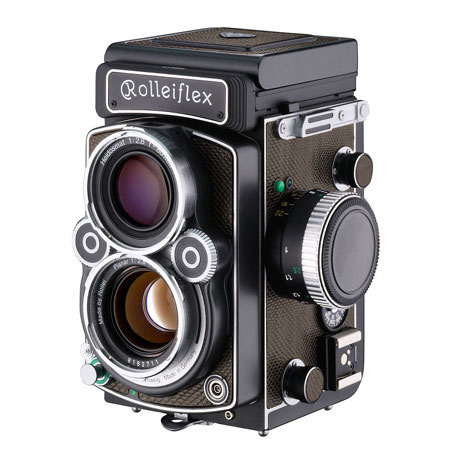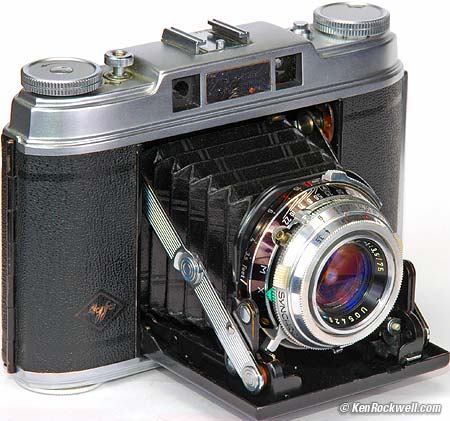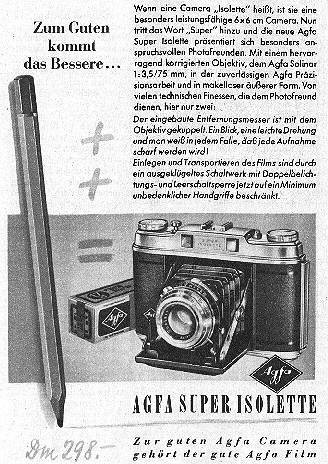Home Search Gallery How-To Books Links Workshops About Contact
|
INTRODUCTION Medium format cameras use film much, much bigger than 35mm or digital, and thus give much higher quality. It's also almost as easy to use as 35mm and digital, and in some ways easier. With quality better than 35 mm or digital and almost equal ease-of-use you'll see why it has always been a popular format for many kinds of professional photography, especially portraiture. You can read up on the film itself and the various kinds of medium formats here. There are two kinds of rolls of film. The original one, called "120," gives 12 square images. A new kind called "220" gives twice as many. Depending on the size of the image made by the camera you'll get more or fewer photos on a roll. Almost all medium format cameras and backs take 120. Many also take 220. Some camera backs, like those from Hasselblad, only take one or the other. Again, there's a lot more here. Avoid cameras taking 620 film. It's been out of production for decades. Today it costs three times as much to buy specially respooled film. The film is the same as 120; just that the spool is smaller. You can use these cameras, just they aren't practical if you have the choice. How to Start Cheap for $300 It's easy to spend just a few hundred dollars and get a camera which can give quality far beyond anything in 35mm or digital. Yes, a $200 used Yashica-MAT can run circles around any Leica, Nikon or Canon camera in digital or film. it even has a faster flash sync speed! How to Buy Used I'll get to new cameras later. You wanted a bargain, right? When buying used the biggest concern is if the shutter works properly. The quickest way to check this is to set it to 1 (second) and time it with your watch. It should click, buzz smoothly for almost exactly one second, and click again. If the buzzing is discontinuous, broken or jerky that means the camera needs a cleaning from lack of use. The oils get stiff over the decades if not used often, and bad examples will simply get stuck open halfway through. The blades should snap open and closed instantly. Oil leaking on them will slow them down. Don't confuse the shutter with the aperture blades. The cost of cleaning and repair is the same as just buying a working camera, so skip one that's not right. Also point a bright light through the taking lens with the shutter open at Bulb and be sure the glass is clean, not foggy. Buying an old used camera is like buying a used diamond or old master painting; it takes a lot of education to do it well, so if you're not good at this best to buy from a legitimate full-time retail dealer with a 100% cash return policy. Forget eBay, you have no way to inspect beforehand and inspection is everything. Exterior appearance has no relation to performance. Twin-Lens-Reflex Cameras (TLRs) Modern Rolleiflex you can get new here. (NOT cheap!) A used TLR is the least expensive way to get reliably great results. TLRs were popular in the 1960s and 1970s. They were the top cameras used for professional and newspaper photography around 1970. Therefore there are a ton of them out there cheap today. Twin-Lens Reflex (TLR) means there are two lenses, one on top of the other. You focus and compose through the top one and make the photo through the bottom one. The ground glass in a TLR reverses the image from left to right, unless you have a prism on the top which few TLRs do. The completely inverted image of a view camera is fine with me, but an image reversed in only one of two planes in a TLR drives me nuts. Therefore I only use the ground glass for focusing and use the sports finder built into all TLRs for composition. To use a TLR you pop open the top cover, which serves as a hood, and look down on the ground glass. There is almost always a magnifier you can pop out for focusing by usually pushing in a little on the front of the hood. Also there is almost always a sports finder put into use by pushing the front of the hood in and up, revealing a peep hole in the back and a square hole in the front. As TLRs lost ground to 35mm SLRs (single-lens-reflexes) in the 1970s some TLRs had marketing-department-invented 35mm adapters available so you could also use 35mm film in a TLR. Skip this. TLR Metering Metering was fine for print film. The metering on any of the TLRs was never all that great if you shoot slides as I do. Test it yourself and set the meter to whatever works well for you. I always had to dial the meter of my Yashica-MAT to a couple thirds of a stop away from the rated film speed. Today just bring you digital camera along in your pocket to use as a meter. Read about that and other meters here. TLR Lenses TLRs have a fixed normal lens. Some TLRs, like the Yashica, offered hokey front-attachments to give mild wide or tele effects. I had one, they worked awful. On the other hand, if you want a softer effect for portraiture the Yashica tele attachment might be great. These attachments included two lenses: one each for top and bottom. Rollei for years has made TLRs with fixed wide or tele lenses. These cameras, which are permanently wide or tele, are harder to find and expensive. Mamiya made TLRs with dual pairs of interchangeable lenses. They made a huge range from 50 mm though I think 250 mm. More below. Close-up lenses for TLRs are clever: the top lens adds a prism to compensate for parallax. TLR Filters Many TLRs take Bay-30 (30mm bayonet) filters. You can find them new or used. I have an excellent Hoya Bay-30 81-A filter if you're interested left over from my Yashica. An advantage of a TLR, just like a rangefinder, is that with dark filters like those used for infra-red, you have no filter over the viewing lens. Thus your viewfinder doesn't get dark or colored. Yashica-MAT TLRs Yashica-MATs were extremely popular in the 1960s and 1970s. They were always decent cameras at a low price, so everyone had one of these Japanese cameras. The most recent version was the Yashica-MAT 124-G. Earlier ones had letters closer to A in the alphabet. The Yashica-MAT 124-G takes 120 and 220 film and has a built-in meter, so it's everything you need in one solid metal brick. Rollei TLRs German Rollei invented the TLR back in the 1920s. They still make them brand new today if you want to spend $3,000 here, which isn't the way to start cheap. Rollei has always made the very best and most expensive cameras, thus any used one of any vintage in correct working order is a great camera. Pass on the earliest ones before coated lenses. In the heydays of TLRs Rolleis were too expensive for anyone to afford, just as they are today. Thus to sell cameras in the 1960s and 1970s Rollei introduced a less expensive line called Rolleicord. Rollei makes no junk. Even an Rolleicord today is a superb camera. It just lacked a few features of the more expensive Rolleiflexes. Many have no meters, many have meters, and some Rolleicords even had built-in program auto exposure without batteries. I think these were called Autocords, or maybe that was Minolta. Rollei also made TLRs with permanently attached wide or tele lenses in place of the normal lens. Mamiya TLRs Mamiya made the junkiest of the Japanese cameras that you're likely to find popular today. They made tons of TLRs and are noted for their C3/ C33 / C330 series which has interchangeable lenses. These cameras has lens assemblies which were, of course, two lenses. They made a broad range from about 50 mm through 250 mm. I had one. The lenses weren't very good, then again, I got a deal on a set with two bodies, case and four lenses that only cost me a few hundred bucks. Minolta and other TLRs Everyone made TLRs back in the days. I never used a Minolta and presume they were swell. Even names like Ansco and Kodak were made in the USA for patriotic types. Seagull TLRs Seagulls are modern, primitive Chinese copies of earlier TLRs. You can get them brand new for a couple of hundred bucks here in a couple of different models. Unlike everything else today that's made in China by companies we know about, from what I've seen these Seagulls are made in the traditional crude domestic Chinese way by a Chinese company. Sure, a Seagull ought to work great. Be careful and you can get results on a Seagull as good as a Mamiya, Rolleiflex or anything else. Of course the photos are the same; but for the same few hundred dollars I'd prefer to spend some time and find an old German Rolleiflex TLR, the camera after which the Seagull is copied. Ditto for a Yashica-MAT 124-G. Either of these is a quality camera. The Seagull works OK, just more primitive. If you 're buying new than the Seagull is your only option; Rolleis are great but literally cost ten times as much. If you have that much to spend then get an SLR like the Hasselblad or a rangefinder like the Mamiya 7, not a TLR like the Rollei. Again, the pix are the same, just that the German cameras are a joy to behold because of the quality of construction. Find one in good shape and even 50 years old they work great. Holga Beware the Holga. It's a toy plastic camera loved by artists for its fuzzy images and light leaks. It's not the camera to get for sharp images. Folding Cameras Agfa Super Isolette of 1953 Folding medium format cameras were popular from the 1930s through the 1950s. They are among the most portable cameras ever made. They fold up and drop in your pocket. Get one with a coated lens, introduced after WWII. The German ones by Agfa and Zeiss were great. Your biggest concern needs to be getting one whose 1.) shutter still works, 2.) focus isn't gummed solid, and 3.) has no holes in the bellows. Fixing 1.) costs more than the camera. Fixing 2.) can be done with a pipe wrench and courage. Fixing 3.) is done daintily with electrical tape. Three-element lenses are mediocre and focus with a rotating front element. They are sharp in the center but need to be stopped down all the way to be sharp in the corners. I've gotten great results with one of these cheapies using ASA 400 print film and just guessing at exposure. They often lack rangefinders; you guess (or measure) the distance and set it on the focus ring. One of these, often found for $10 at a garage sale, can give great results. My lab thought I had bought a Hasselblad! Most of them will need some sort of renovation as mentioned in 1, 2, and 3 above. The better ones, like the expensive Agfa above, use four element Tessar-variant lenses and focus by moving the entire lens assembly. This lens is marvelously sharp even wide open. These cameras came from the cheapest versions with fixed or three-speed shutters and guess-by-scale focusing to expensive models with great lenses and complete shutters and coupled rangefinders (in the Agfa above) or at least built-in uncoupled rangefinders. On many of these cameras the rangefinder worked like a modern camera's, however you had to look at the footage displayed and manually transfer it to the lens' focus scale. All modern cameras have coupled rangefinders, meaning the lens is coupled to the rangefinder. You can get great results if you look around and do some repair, but getting one of these from the 1950s is more hit and miss than getting a Yashica-MAT from the 1970s. Avoid any that have had someone else's pipe wrench applied, so avoid eBay like the plague. The Agfa above was always an expensive camera. In 1953 it sold new for $150, over $1,000 in today's money, the same as a Hasselblad. I paid $350 for mine used in 1994. Here's an ad for it Here's a great website about folding cameras. Digital Scanning and Printing I have scanner suggestions here. Projection Because the 6 x6 square format was popular for everyone in the 60s and 70s there are plenty of projectors out there. Personally I found a used modern Kindermann 6 x 6 projector and use that. The modern projectors all use a small 250 W quartz halogen bulb. The older projectors used larger 500 W conventional incandescent bulbs. Try to avoid these, although there are a ton of them out there in people's attics. A key here is that Kindermann and Rollei and Linhof always made great expensive projectors. Look for these. Others, like Kodak, Ansco, Revere and other names forgotten to history made the amateur ones my parents bought. Get one to start, but keep looking for a modern one. The halogen ones are bright and sharp. The amateur ones are dim and fuzzy. You project 645 film in a 6 x 6 projector. Larger formats, like 6 x 7, becomes tougher to find. Mamiya offers some today. There are projectors out there from the old days, but not that many. Look for Rollei and Linhof. They will be big and heavy, and you'll probablty have to load each slide by hand one-by-one. Better New Cameras By all means go get a modern Hasselblad or Rollei. They are, and always have been, magnificent cameras. Buy any used gear from the Germans and Swedes and it's also excellent. Modern Mamiyas are much better than they were in the 1970s and before. See here for a page on modern bargains on brand-new Mamiya cameras. |



